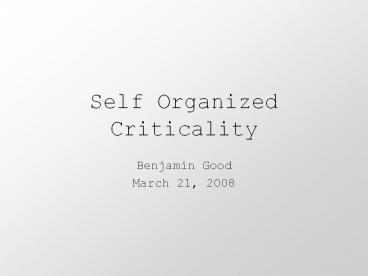Self Organized Criticality - PowerPoint PPT Presentation
Title:
Self Organized Criticality
Description:
Self Organized Criticality (SOC) is a concept first put forth by Bak, Tang, and ... The critical sandpile also displays a phenomenon called 1/f noise. ... – PowerPoint PPT presentation
Number of Views:114
Avg rating:3.0/5.0
Title: Self Organized Criticality
1
Self Organized Criticality
- Benjamin Good
- March 21, 2008
2
What is SOC?
- Self Organized Criticality (SOC) is a concept
first put forth by Bak, Tang, and Wiesenfeld (all
theoretical physicists) in their famous 1988
paper. - SOC models have been applied to earthquakes,
evolution, neuron-processes, quantum gravity, and
many other areas. - It centers around two key concepts Criticalit
y a concept from statistical physics
characterized by a lack of a characteristic
time/length scale, fractal behavior, and
power laws. Self Organized this
critical state arises naturally, regardless of
initial conditions, rather than requiring
exactly tuned parameters.
3
Characteristics of Criticality
- Divergence of the correlation length ? introduced
in Yeomans book. - Certain observables (e.g. distribution of patch
sizes) obey power laws - Universality extremely different systems
display the same behavior regardless of their
dynamical rules. - System is often sensitive to small perturbations.
- However, criticality is usually obtained by
finely tuning a parameter (e.g. temperature for
phase transitions), so they would be unlikely to
naturally arise.
4
The BTW Model Sand Piles
- The original SOC model was based on sand piles.
- Sand piles can reach a critical state where the
addition of just one more piece of sand can
trigger an avalanche of any size. - The concept of universality ensures that
studying this model can tell us much about
other processes, despite the silly nature of
the particular example.
5
BTW Model in 1-D
- There are N points on a line, and the height of
sand at a point x is given by h(x). - The slope, z(x), at a point x is then given by
z(x) h(x) h(x)1 - To add a piece of sand at a point x, we
take z(x) z(x)1 z(x-1) z(x-1)-1 - If the slope at any one point is higher than
some critical value zc, a piece of sand
fallsdown z(x) z(x) -2 z(x1)
z(x1)1
6
BTW Model in 1-D
- The pile is stable if z(x) zc for all x, so
there are zcN stable configurations. - If sand is added randomly, the system will reach
the minimally stable state (z(x) zc for all x).
If an extra piece of sand is added, it just
falls all the way down the pile and off the
edge. - Thus, no interesting behavior in the
1-Dimensional case. SOC is not present.
7
BTW Model in 2-D
- To see interesting behavior, the model must have
D 2. - In two dimensions, the height is given by h(x,y)
and the slope by z(x,y) 2h(x,y)-h(x1)-h(x,y1) - Our rules new 2-D rules becomeAdding z(x,y)
z(x,y)2 z(x-1,y)z(x-1,y)-1
z(x,y-1)z(x,y-1)-1Falling z(x,y) z(x,y)
4 z(x 1,y) z(x 1, y)1
z(x,y 1) z(x, y 1)1
8
BTW Model in 2-D
- Will the system evolve towards the minimally
stable state again? - NO! Because each point is connected to more than
one other point, a small perturbation amplifies
and travels throughout the entire pile. - Thus, the minimally stable state is unstable with
respect to small fluctuations and cannot be an
attractor of the dynamics.
9
BTW Model in 2-D
- As the system evolves, more and more more than
critically stable patches arise and will impede
the motion of the perturbation. - Thus, the pile seems to be in a critical state,
and since it arose on its own, it is a self
organized critical state. Now we start looking
for power laws.
10
Power Laws and Avalanche Sizes
- Critical states are slightly perturbed and the
resulting avalanches are measured. - We then form a distribution of avalanche sizes
D(s) and try to fit it to a power law.
11
1/f Noise
- The critical sandpile also displays a phenomenon
called 1/f noise. - This means that its power spectrum, defined by
follows the form S(f) 1/fb for b1. - This differs from random white noise, which is
given by 1/f0 and that of a random (Brownian)
walk, which is given by 1/f2. 1/f noise is
usually defined as anything with 0ltblt2
12
Applications to evolution
- Many researchers (including Bak himself) have
been inspired to apply SOC concepts to evolution. - This was prompted by several studies that
discovered power law-like behavior in
extinctions, evolutionary activity, etc. - SOC models are appealing in this context, because
they offer a natural explanation for how these
phenomena arose (they self organized), whereas
many existing models yield the desired power laws
only if certain parameters are tuned. - However, much of the justification for SOC models
is based only on the fact that power laws are
observed.
13
Are power laws enough evidence for SOC?
- Newman, in a 1995 paper on the evidence for SOC
in evolution, asks whether power laws are
actually present in the data and whether this is
enough to imply SOC in evolutionary processes. - Results although the evidence for power laws
is good, additional non-SOC mechanisms could
account for them (e.g. environmental stresses).































